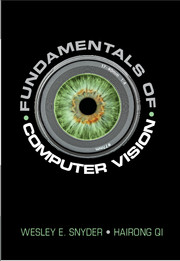Book contents
- Frontmatter
- Dedication
- Contents
- Preface
- For the Instructor
- Part I Preliminaries
- 1 Computer Vision, Some Definitions, and Some History
- 2 Writing Programs to Process Images
- 3 Review of Mathematical Principles
- 4 Images: Representation and Creation
- Part II Preprocessing
- Part III Image Understanding
- Part IV The 2D Image in a 3D World
- A Support Vector Machines
- B How to Differentiate a Function Containing a Kernel Operator
- C The Image File System (IFS) Software
- Author Index
- Subject Index
- References
1 - Computer Vision, Some Definitions, and Some History
from Part I - Preliminaries
Published online by Cambridge University Press: 25 October 2017
- Frontmatter
- Dedication
- Contents
- Preface
- For the Instructor
- Part I Preliminaries
- 1 Computer Vision, Some Definitions, and Some History
- 2 Writing Programs to Process Images
- 3 Review of Mathematical Principles
- 4 Images: Representation and Creation
- Part II Preprocessing
- Part III Image Understanding
- Part IV The 2D Image in a 3D World
- A Support Vector Machines
- B How to Differentiate a Function Containing a Kernel Operator
- C The Image File System (IFS) Software
- Author Index
- Subject Index
- References
Summary
No object is mysterious. The mystery is your eye.
– Elizabeth BowenIntroduction
There are two fundamentally different philosophies concerning understanding the brain. (1) Understand the brain first. If we can understand how the brain works, we can build smart machines. (2) Using any technique we can think of, make a smart machine. If we can accomplish that, it will give us some hints about how the brain works. This book is all about the second approach, although it draws from current understanding of biological computing. In this chapter, however, we define a few terms, introduce the greater localglobal problem, and then give a very brief introduction to the function of the mammalian brain.
• (Section 1.2) From signal and systems perspective, we describe the differences between Computer Vision and some other closely related fields of studies, including, e.g., image processing and pattern recognition.
• (Section 1.3) Since almost all problems in Computer Vision involve the issue of localness versus globalness, we briefly explain the “local-global” problem and the “consistency” principle used to solve this problem.
• (Section 1.4) Computer Vision is deep-rooted in biological vision. Therefore, in this section, we discuss the biological motivation of Computer Vision and some amazing discoveries from the study of the human visual system.
Some Definitions
Computer Vision is the process whereby a machine, usually a digital computer, automatically processes an image and reports “what is in the image.” That is, it recognizes the content of the image. For example, the content may be a machined part, and the objective may be not only to locate the part but to inspect it as well.
Students tend to get confused by other terms that often appear in the literature, such as Image Processing, Machine Vision, Image Understanding, and Pattern Recognition.
We can divide the entire process of Image Processing into Low-Level Image Processing and High-Level Image Processing. If we interpret these processes from signal and systems perspective, it is more clear to describe their difference and similarity from the format of input/output of the system. When a Low-Level Image Processing system processes an input image, the output is still an image, but a somewhat different image. For example, it may be an image with noise removed, an image that does not take as much storage space as the input image, an image that is sharper than the input image, etc.
- Type
- Chapter
- Information
- Fundamentals of Computer Vision , pp. 3 - 10Publisher: Cambridge University PressPrint publication year: 2017



